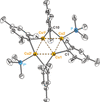issue contents
June 2021 issue

Cover illustration: The molecular salt (S)-alanine ethyl ester tetracyanidoborate, (C5H12NO)[B(CN)4] (C5H12NO)[B(CN)4], was obtained during ongoing efforts to investigate tetracyanidoborate-based ionic liquids. The asymmetric unit contains two (S)-alanine ethyl ester cations and two tetracyanidoborate anions, which are linked by N—H⋯N hydrogen bonds. The compound exhibits a relatively low melting point of 110°C and shows a solid–solid phase transition near room temperature (Ts–s = 29°C) on the basis of DSC measurements. See: Peppel & Köckerling [IUCrData (2021). 6, x210562].
metal-organic compounds


 access
access

 access
access

 access
access

 access
accessorganic compounds


 access
access

 access
access

 access
access

 access
access

 access
access

 access
access

 access
access

 access
access

 journal menu
journal menu























![[publCIF]](/logos/authorchecklist11.gif)





